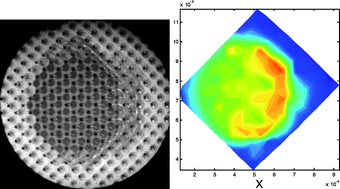Strongly enhanced static friction using a film-terminated fibrillar interface†
Abstract
We examine the behavior under shear of a bio-inspired fibrillar interface that consists of poly(dimethlysiloxane) micro-posts terminated by a thin film. These structures demonstrate significantly enhanced adhesion due to a crack trapping mechanism. We study the response of this structure to shear displacement relative to a spherical indenter placed on its surface under a fixed normal force. The shear force required to initiate sliding between the indenter and the sample, its static friction, is strongly enhanced compared to a flat control, and increases with inter-fibril spacing. Examination of the contact region reveals that its area changes with applied shear and that static friction is controlled by a mechanical instability. The shear force resisting steady sliding, surprisingly, is independent of fibril spacing and is nearly the same as for the flat unstructured control samples. We interpret dynamic friction to result from the action of Schallamach-like waves. Our results show that the film-terminated architecture can be used to design an interface with significantly enhanced static friction without altering its sliding frictional resistance.


 Please wait while we load your content...
Please wait while we load your content...